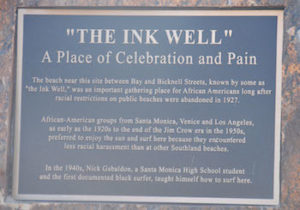
*The Inkwell, a public Los Angeles beach is affirmed on this first day of summer in 1905.
The Inkwell is a beach where black Californian’s and black visitors to Santa Monica, CA enjoyed the Pacific Ocean. In the early 20th century a two-block area of Pacific oceanfront in Santa Monica, stretching from the western end of Pico Boulevard to Bicknell Street, became a popular gathering place for African Americans.
The segregationist white community called it the “Inkwell” in reference to the skin color of the beach goers. The beach was (is) near the Ocean Park neighborhood near Phillips Chapel Christian Methodist Episcopal (CME) Church. Phillips was founded in 1905 as the first black church in Santa Monica, which also anchored an early African American settlement around 4th and Bay Streets. African Americans from throughout Southern California socialized, enjoyed the Inkwell because they experienced less racial harassment there than at other area beaches.
California had laws from as early as the 1890s about public beach access for all citizens that were not acknowledged by whites. There were personal assaults on individual African Americans to prevent freedom at public beaches north and south of Santa Monica. By 1927, as a result of legal challenges led by the National Association of Colored People (NAACP), the California Courts upheld the laws put in place from 1893 to 1923 that provided equal access to any public beach in the state.
Also in the mid-1920s white beach clubs began to open near the foot of Pico Boulevard, pushing the Inkwell beach site south towards Bay and Bicknell Streets. At the same time the Santa Monica Bay Protective League blocked the development efforts of a black investment group, the Ocean Frontage Syndicate led by Norman O. Houston and Charles S. Darden, Esq., with plans to build a first-class resort with beach access where Shutters Hotel is located today. Pushed southward by exclusive clubs from which they were restricted and simultaneously denied their own club, the black community’s presence continued at the Ocean Park neighborhood beach as a safer haven from racism.
As racial and legal barriers began to crumble from 1948 to 1968, with the overturning of restrictive real estate covenants and the prohibition of most forms of discrimination, sites of black leisure activity began to integrate. No longer a segregated space today, the Inkwell beach site includes the California Wash art installation and Crescent Bay Park. While the Inkwell beach site is itself largely gone (a monument marking the site was installed in 2008), the story of the site and the people who used it remains. In 2008 the City of Santa Monica erected a monument at Bay Street and Oceanfront Walk, officially recognized the historic significance of its early African American community.